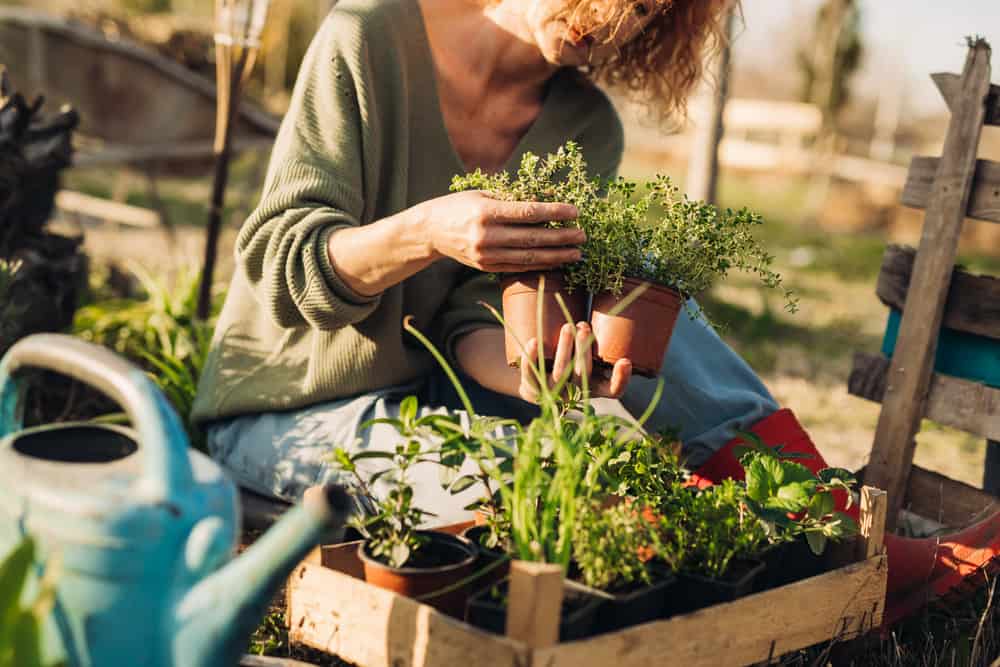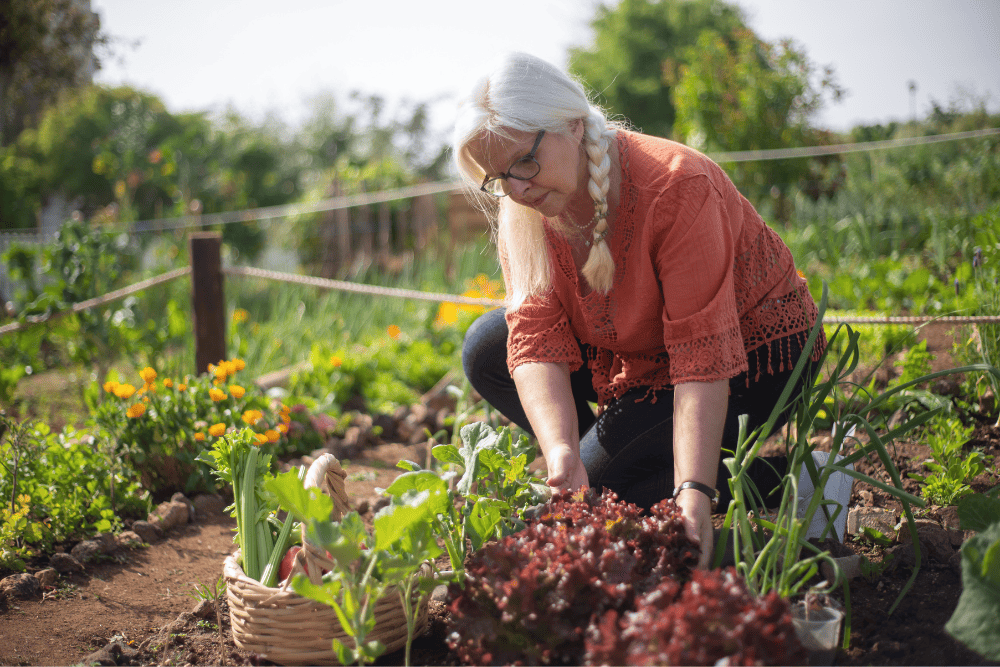Are you interested in growing food like herbs, fruits, and vegetables while also enjoying a pretty garden? Then a potager garden might be just what you need.

This age-old gardening approach combines edible and ornamental plants in one harmonious space. Learn how these gardens came to be and the features they usually include. Then get step-by-step instructions on how to plan and plant your own garden.
The origins of potager gardens
A potager garden is a carefully designed kitchen garden with vegetables, fruits, edible flowers, and herbs. The word “potager” comes from the French word “potage,” meaning soup or stew.
This gardening method began as a way to create vegetable gardens for large estates, medieval monasteries and castles. These early potagers focused on practicality over pretty gardens, but they’ve evolved into carefully designed forms of herb gardens or vegetable gardens suitable for any home.
Over time, gardening became more popular among the nobility. During the Renaissance, potagers began planting ornamental shrubs and companion plants alongside edible ones to create beautiful gardens.
One famous example is the Potager du Roi (King’s Kitchen Garden) at Versailles Palace in France.
Combining pretty with practical
Modern potager gardens combine beauty with function by using different design elements.
Think about the geometric patterns of herb gardens. Or meandering pathways between berry bushes and fruit trees. You’ll even find pretty flowers planted between rows of colorful vegetables like tomatoes and peppers.
Many people love this type of garden as it allows them to provide food for their families. At the same time, they get to enjoy a stunning outdoor area suitable for leisure or hosting guests at a summer barbecue. Some gardens may even include small conservatory-style greenhouses.
To learn more about designing your beautiful yet functional garden, check out resources like “The American Potager Handbook” for inspiration and guidance.
I find the easiest thing to grow in a kitchen garden is green onions (or scallions). Just add soil to a pot, poke holes in the soil, add the white bulbs of the green onion to the pot with the roots facing downward, gently compact the soil, and water your cuttings. Then leave them in the sun to grow!
Gen La Rocca, Two Cloves Kitchen
Benefits of a potager garden
Modern potager gardens are often designed with an informal or romantic style influenced by organic gardening principles. A well-designed garden provides many benefits.
- It does double duty as a landscape feature and food source.
- Potager or kitchen gardens use sustainable and organic techniques, like composting, crop rotation, and all-natural fertilizers.
- They provide food and year-round access to fresh produce using cold frames or greenhouses, even during colder months. This helps reduce grocery bills and gives your family access to nutrient-rich food all year round.

Companion planting and ornamental plants
Many potagers use companion planting strategies where certain plant species are grown together because they benefit each other. For example, growing basil near tomatoes improves their flavor. And studies show that growing marigolds help deter nematodes (microscopic worms) from attacking root crops.
In addition to edible varieties, ornamental plants and decorative flowers like nasturtiums attract insects that prey on common pests keeping them under control naturally within the ecosystem created by your garden space.
Common potager vegetables and herbs
When designing your garden, remember to include herbs and vegetables that add flavor and visual interest. Parsley, dill and rosemary are popular options. Just make sure you have good drainage when you plant them.
Tomatoes and leafy greens
Tomatoes are a popular choice for any vegetable garden due to their versatility in recipes and ease of growing. In addition, they come in various shapes, sizes and colors, which can add visual interest to your potager.
Similarly, leafy greens like spinach, kale or Swiss chard offer nutritional value and ornamental features with their vibrant foliage.
And remember to try growing broccoli seeds in your garden.
Root crops and legumes
Incorporating root crops such as carrots, potatoes, and beets into your potager design is a great way to add inexpensive veggies to your backyard garden.
And legumes like beans or peas are also great additions because legumes enrich the soil. by fixing nitrogen through symbiotic relationships with bacteria present on their roots.
Climbing varieties of these legumes can grow up trellises or other vertical structures, adding another layer of beauty.
Tip: Try vertical gardening to maximize your outdoor gardening space.
Culinary herbs
Culinary herbs enhance the flavors of your home-cooked meals. They also play a vital role in natural pest management strategies within your garden. You might like growing these:
- Basil is a versatile herb used in many cuisines and has a strong aroma that repels pests like aphids.
- Mint is known for its refreshing flavor and can deter pests such as ants and mice.
- Sage is a popular herb in savory dishes with a strong scent that deters cabbage moths and carrot flies.
- Thyme is an essential ingredient in many recipes and attracts beneficial insects like ladybugs while repelling harmful ones like whiteflies.
Including these aromatic plants will create an ecosystem that promotes healthy growth without relying on chemical pesticides.
Mint is such an easy herb to grow, so it is a great one for beginners. Be careful though — it can take over garden beds, so it works better in a container.
— Susannah Brinkley Henry, Feast + West
Five steps to starting your own potager garden
To start your own potager garden, follow these five steps.
#1. Choose an ideal location
Select a location close to your home or kitchen area for easy harvesting and regular maintenance. Make sure this spot gets enough sunlight (no less than 6 to 8 hours daily) and has decent water flow. This will provide the best growing conditions for most vegetables and herbs commonly grown in potager gardens.
#2. Determine size and shape
Determine the size and shape of your plot based on available space. Consider incorporating raised beds or containers.
Raised beds offer several advantages, such as improved soil quality, better drainage, easier weed control and higher yields compared to traditional in-ground gardens.
#3. Select favorite foods to grow
Plan out which vegetables you love eating most as primary crops. This may include veggies such as tomatoes, leafy greens, root crops and legumes.
Select culinary herbs you’ll use in your cooking, such as basil, mint, sage, thyme, dill, chives, cilantro, rosemary and parsley. These herbs not only enhance flavors but also repel harmful insects due to their strong scents.
Finally, include edible landscaping elements like fruit trees and berry bushes for added variety and visual interest in your potager garden.

#4. Design a pretty and practical layout
Create a layout that suits the environment and setting while also considering plant productivity factors such as sunlight exposure requirements and good drainage.
Grow vegetables in geometric patterns or informal groupings based on their growth habits, colors, textures and companion planting principles. This will look nice and promote healthy plant growth. Learn more about companion planting before you start.
#5. Add some character
The best potagers know their gardens need some character. So look for non-plant components to add visual interest and delight your visitors.
Try creating paths from natural materials like gravel or wood chips in larger gardens.
Place unique DIY planters or decorative pots at the entrance to your garden filled with matching edible flowers.
Or add a few functional items like rainwater barrels and compost bins that blend seamlessly into the overall design of your potager garden.
These elements add visual appeal and contribute to sustainable gardening practices.
What flowers are best for a potager garden?
Incorporating flowering plants into a potager garden adds color while attracting pollinators essential for vegetable production.
Some popular choices include marigolds (for pest control), nasturtiums (edible), lavender (aromatic & insect repellent), calendula (medicinal & edible), borage (attracts bees) and sunflowers (supports climbing plants).
You need a potager garden
A potager garden is an excellent way to cultivate fresh produce and herbs while adding beauty to your homestead. Following the steps outlined in this post, you can start your potager garden and enjoy its many benefits.
Remember to choose the right location, prepare the soil properly, select plants that work well together, design a layout that suits your needs and style preferences and maintain it with regular watering and pest control measures.
With these tips in mind, you’ll be on your way to growing a thriving potager garden that nourishes both body and soul.
Sarita Harbour is a homeschooling, homesteading mom and a long-time business and finance writer. Sarita created An Off Grid Life to help people become more self-reliant. Sarita and her family live off the grid in Canada’s Northwest Territories.
